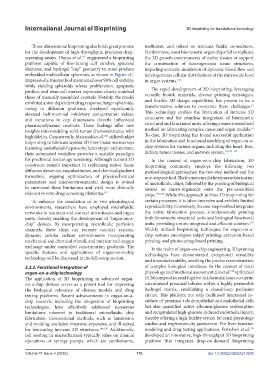Page 118 - v11i4
P. 118
International Journal of Bioprinting 3D bioprinting for translational toxicology
Three-dimensional bioprinting also holds great promise inefficient, and reliant on intricate fluidic connections.
for the development of high-throughput, precision drug- Furthermore, most biomimetic organ chips fail to replicate
screening assays. Utama et al. engineered a bioprinting the 3D growth environments of native tissues or support
147
platform capable of fine-tuning cell number, spheroid the construction of heterogeneous tissue structures,
diameter, and hydrogel “cup” geometry to mass-produce impeding accurate simulation of dynamic blood flow and
embedded multicellular spheroids, as shown in Figure 4C. heterogeneous cellular distributions at the microscale level
Impressively, this method maintained over 98% cell viability in organ systems. 151
while yielding spheroids whose proliferation, apoptotic The rapid development of 3D bioprinting, leveraging
profiles, and stem-cell marker expression closely matched
those of manually assembled controls. Notably, the model versatile bioink materials, diverse printing techniques,
exhibited a size-dependent drug response: larger spheroids, and flexible 3D design capabilities, has proven to be a
16
owing to diffusion gradients, displayed significantly transformative solution to overcome these challenges.
elevated half-maximal inhibitory concentration values, This technology enables the fabrication of intricate 3D
and variations in cup dimensions directly influenced structures and the seamless integration of biomimetic
pharmacodynamic readouts. These findings offer new structural and functional units, offering a more streamlined
16
insights into modeling solid-tumor chemoresistance with method for fabricating complex tissue and organ models.
high fidelity. Concurrently, Matsusaki et al. utilized inkjet To date, 3D bioprinting has found successful application
148
bioprinting to fabricate layered 3D liver‐tissue microarrays in the fabrication and functional modeling of organ-on-a-
featuring endothelial-hepatocyte heterotypic architecture; chip systems for various organs, including the heart, liver,
their automated workflow provides a scalable paradigm kidney, tumor tissues, and nervous system. 19,152–154
for preclinical toxicology screening. Although current 3D In the context of organ-on-a-chip fabrication, 3D
constructs remain imperfect in replicating native tissue bioprinting commonly employs the following two
diffusion dynamics, vascularization, and chemical gradient methodological approaches: the two-step method and the
formation, ongoing optimization of physicochemical one-step method. The former entails the separate fabrication
parameters and microenvironmental design is poised of microfluidic chips, followed by the printing of biological
to surmount these limitations and yield more clinically tissues or micro-organoids onto the pre-assembled
relevant in vitro drug‐screening platforms. chips. 155,156 While this approach utilizes 3D bioprinting for
83
To enhance the simulation of in vivo physiological certain processes, it is labor-intensive and exhibits limited
environments, researchers have employed microfluidic reproducibility. Conversely, the one-step method integrates
networks to maintain and connect microtissues and organ the entire fabrication process, simultaneously printing
units, thereby enabling the development of “organ-on-a- both biomimetic structural units and biological functional
157
chip” devices. By incorporating microfluidic perfusion units, providing a more integrated and efficient solution.
channels, these chips can recreate vascular systems, Widely utilized bioprinting techniques for organ-on-a-
dynamic cellular culture environments incorporating chip systems encompass inkjet printing, extrusion-based
mechanical and chemical stimuli, and nutrient and oxygen printing, and photocuring-based printing.
exchange under controlled concentration gradients. The In the realm of organ-on-chip engineering, 3D printing
specific features and applications of organ-on-a-chip technologies have demonstrated exceptional versatility
technology will be discussed in the following section. and manufacturability, enabling the precise reconstruction
3.3.2. Functional integration of of complex biological interfaces. In the context of renal
158
organ-on-a-chip technology physiology and functional assessment, Lin et al. optimized
The application of 3D bioprinting in advanced organ- ECM composition and fugitive‐ink formulations to co-print
on-a-chip devices serves as a potent tool for improving vascularized proximal tubules within a highly permeable
the biological relevance of disease models and drug hydrogel matrix, establishing a closed‐loop perfusion
testing platforms. Recent advancements in organ-on-a- circuit. This platform not only facilitated functional co-
chip research, including the integration of bioprinting culture of proximal-tubule epithelial and endothelial cells
technologies, have effectively addressed numerous but also quantified active albumin/glucose reabsorption
limitations inherent to traditional microfluidic chip and recapitulated high-glucose-induced endothelial injury,
fabrication. Conventional methods, such as lamination thereby offering a high-fidelity system for renal physiology
and molding, are labor-intensive, expensive, and ill-suited studies and nephrotoxicity assessment. For liver function
for fabricating intricate 3D structures. 149,150 Additionally, modeling and drug testing applications, Fritschen et al.
159
cell seeding in microchannels typically relies on manual developed an innovative, high-throughput 3D bioprinting
operations or syringe pumps, which are cumbersome, platform that integrates drop-on-demand bioprinting
Volume 11 Issue 4 (2025) 110 doi: 10.36922/IJB025210209

